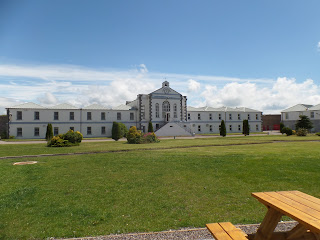Our last night in Ireland, and very sad to leave. Such a beautiful country, and with equally lovely friendly people. There is a positive feel here, and an optimism for the future.
It also a foodie country, with excellent restaurants and cafes. This was an unexpected surprise. There is traditional food of course but most places try to experiment with different ideas and ingredients. And of course the fresh fish is excellent.
We mostly enjoyed visiting the smaller towns and villages, although Dublin was interesting in a very quirky way. Cork was just plain lovely.
The museums were also great and stories were told simply and in an interesting manner. The Irish are great story tellers.
The camping grounds were very good, although some of them a bit too expensive for the mediocre facilities they offer. The one in Wexford, with lawns that need mowing, charge €31 a night plus extra for showers. It may be on the harbour but it is not the Cote d'Azur.
The camping ground at Blarney was tops, superbly manicured lawns and hedges, electricity and showers included, and the cheapest one at €12 per night, due to booking for a week. The price is normally €25 per night. We certainly spent a very happy five nights there.
The landscaped little garden in the middle of the camping ground at Blarney.
Our experience of Blarney village, the service station, supermarket and takeaway food shop. The actual Blarney village, which we visited on the last day, was considerably more upmarket.
We drove to Barney Castle to have a look. After trying to find a carpark among the coaches and cars, we managed to catch a glimpse of the tower through the trees.
There was also a huge Woollen Mill shop and hotel there, once the premises of the actual woollen mill, I think. Last night I walked to the entrance of the camping ground, and stood on a low fence in order to capture another view of the tower of Blarney Castle.
Today we drove about 170 kms to Wexford, through undulating countryside. Sadly we were unable to visit Waterford which is not far from here. It just became all too much in the end. We also missed a chance to purchase some Waterford crystal.
We went for another walk through Wexford tonight to see if the place looked as dilapidated as it did when we arrived three weeks ago. Sometimes first impressions are not always accurate. The sun was shining today and it did make the town look much better. However there is an aura of poverty about the place, which is hard to ignore.
Wexford gets an excellent write up in tourist brochures, for its interesting restaurants and cafes and historical sites.

The final ruin. An abbey in Wexford.
Tomorrow we will be getting up early in order to catch the ferry from Rosslare at 9 a.m. Hope the weather is good. And then it is home to Britain, and the full fury of the Brexit fiasco. Ireland has been quite a haven.
I was determined not write anything about the situation in Britain, but cannot resist just a few lines.
The Labour Party is in a mess. The current leader Jeremy Corbyn refuses to resign, even though there is a vote of no confidence in him.
Nigel Farage, UKIP, is an absolute twit, as per his speech in the European Parliament yesterday.
There were no prior plans made for a Brexit, either by the Leave campaign or by David Cameron, in case the majority of voters voted for 'Leave'. The Chanchellor, George Osborne, stated 'It wasn't our responsibility to have a plan for leaving the EU'.
Brexit has been praised by Rupert Murdoch, Donald Trump and Marine Le Pen, the leader of the ultra right wing party in France.
At the moment Britain has lost much of its credibility, I think.

























































